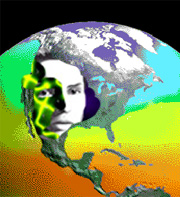| Tuesday, February 15, 2005 |
| Global Consciousness Project |
 The Global Consciousness Project is getting some press recently. The Global Consciousness Project is getting some press recently. DEEP in the basement of a dusty university library in Edinburgh lies a small black box, roughly the size of two cigarette packets side by side, that churns out random numbers in an endless stream. It is simply a random number generator. It generates a lot of random ones and zeros. And a bunch of separate devices in different places do the same thing. And the thing is that the results are influenced by big global events. The numbers suddenly become less random and more coherent. And one can easily calculate how much they deviate from what they were "supposed" to be. And how unlikely that would be to be pure coincidence. And the fun thing is also that the results show a little before the actual events happen. That isn't terribly strange, if we assume that everything is connected, and exists in the same unified quantum field. But it makes many scientists very nervous. Apparently they're becoming more comfortable with the idea, as the can't really get around the results, however much they try. It isn't really worth much in predicting the future. All it shows is that something big is going on, or is going to happen shortly, which will be important to many people. But it gives no clue as to what it is going to be. So, mainly it probably serves to make consciousness something that science can't ignore. Which is a valuable aim in itself. [ Science | 2005-02-15 15:39 | 19 comments | PermaLink ] More > |
| In the mind of an autistic savant |
 From the Guardian: From the Guardian: Daniel Tammet is an autistic savant. He can perform mind-boggling mathematical calculations at breakneck speeds. But unlike other savants, who can perform similar feats, Tammet can describe how he does it. He speaks seven languages and is even devising his own language. Now scientists are asking whether his exceptional abilities are the key to unlock the secrets of autism.... Yeah, you're doing that alright. The mind is an amazing thing. Of course, what savants can do indicates that it ought to be possible for anybody, if you knew how. Unfortunately, however amazing it is that he describes what goes on as he does it, that still doesn't make it teachable. Because he doesn't use any clever formulas or anything. But he obviously uses a kind of synesthesia that works, without much effort. [ Knowledge | 2005-02-15 15:50 | 7 comments | PermaLink ] More > |